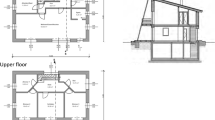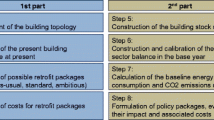Abstract
-
Goal Scope and Background. The European Directive on Energy Performance of Buildings which came into force 16 December 2002 will be implemented in the legislation of Member States by 4 January 2006. In addition to the aim of improving the overall energy efficiency of new buildings, large existing buildings will become a target for improvement, as soon as they undergo significant renovation. The building sector is responsible for about 40% of Europe's total end energy consumption and hence this Directive is an important step for the European Union in order that it should reach the level of saving required by the Kyoto Agreement. In this the EU is committed to reduce CO2 emissions relative to the base year of 1990 by 8 per cent, by 2010. But what will be the impact of the new Directive, how large could be the impacts of extending the obligation for energy efficiency retrofitting towards smaller buildings? Can improvement of the insulation offset or reduce the growing energy consumption from the increasing installation of cooling installations? EURIMA, the European Insulation Manufacturers Association and EuroACE, the European Alliance of Companies for Energy Efficiency in Buildings, asked Ecofys to address these questions.
Methods
The effect of the EPB Directive on the emissions associated with the heating energy consumption of the total EU 15 building stock has been examined in a model calculation, using the Built Environment Analysis Model (BEAM), which was developed by Ecofys to investigate energy saving measures in the building stock. The great complexity of the EU-15 building stock had to be simplified by examining five standard buildings with eight insulation standards, which are assigned to building age and renovation status. Furthermore, three climatic regions (cold, moderate, warm) were distinguished for the calculation of the heating energy demand. This gave a basic 210 building types for which the heating energy demand and CO2 emissions from heating were calculated according to the principles of the European Norm EN 832.
Results and Discussion
The model calculations demonstrates that the main contributor to the total heating related CO2 emissions of 725 Mt/a from the EU building stock in 2002 is the residential sector (77%) while the remaining 23% originates from non-residential buildings. In the residential sector, single-family houses represent the largest group responsible for 60% of the total CO2 emissions equivalent to 435 Mt/a.
-
- The technical potential: If all retrofit measures in the scope of the Directive were realised immediately for the complete residential and non-residential building stock the overall CO2 emission savings would add up to 82 Mt/a. An additional saving potential compared to the Directive of 69 Mt/a would be created if the scope of the Directive was extended to cover retrofit measures in multi-family dwellings (200-1000m2) and non-residential buildings smaller than 1000m2 used floor space. In addition including the large group of single-family dwellings would lead to a potential for additional CO2 emission reductions compared to the Directive of 316 Mt/a.
-
- Temporal mobilization of the potential: Calculations based on the building stock as it develops over time with average retrofit rates demonstrated that regulations introduced following the EPB Directive result in a CO2 emissions decrease of 34 Mt/a by the year 2010 compared to the business as usual scenario. Extending the scope of the EPB Directive to all residential buildings (including single and multi-family dwellings), the CO2 emission savings potential over the 'business as usual' scenario could be doubled to 69 Mt/a in the year 2010. This creates an additional saving potential compared to the Directive of 36 Mt/a.
-
- Cooling demand: The analysis demonstrated that in warm climatic zones the cooling demand can be reduced drastically by a combination of lowering the internal heat loads and by improved insulation. With the reduction of the heat loads to a moderate level the cooling demand, e.g. of a terraced house located in Madrid, can be reduced by an additional 85% if the insulation level is improved appropriately.
Conclusions
This study demonstrates that the European Directive on Energy Performance of Buildings will have a significant impact on the CO2 emissions of the European building stock. The main saving potential lies in insulation of the existing building stock. Beyond this, CO2 emissions could, however, be greatly reduced if the scope of the Directive were to be extended to include retrofit of smaller buildings.
Recommendation and Perspective
The reductions should be seen in relation to the remaining gap of 190 Mt CO2 eq. per annum between the current emission levels of EU-15 and the target under the Kyoto-Protocol for the year 2010. The energy and industrial sector will probably contribute only a fraction of this reduction via the newly established EU emissions trading scheme and connected projects under the flexible mechanism. In addition, the traffic sector is likely to continue its growth path leading to a widening of the gap. Thus, there is likely to be considerable pressure on the EU building sector to contribute to the EU climate targets beyond what will be achieved by means of the current EPB Directive. Legislators on the EU and national level are therefore advised to take accelerated actions to tap the very significant emission reduction potentials available in the EU building stock.
Similar content being viewed by others
Author information
Authors and Affiliations
Corresponding authors
Rights and permissions
About this article
Cite this article
Petersdorff, C., Boermans, T. & Harnisch, J. Mitigation of CO2 Emissions from the EU-15 Building Stock. Beyond the EU Directive on the Energy Performance of Buildings (9 pp). Env Sci Poll Res Int 13, 350–358 (2006). https://doi.org/10.1065/espr2005.12.289
Received:
Accepted:
Published:
Issue Date:
DOI: https://doi.org/10.1065/espr2005.12.289




